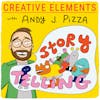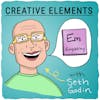
Phill Agnew is the host of Nudge, which explores the behavioral science of marketing.
WATCH
▶️ Watch this episode on YouTube
***
EPISODE DESCRIPTION
Phill Agnew is the host of The Nudge Podcast.
On his podcast, Phill dives deep into the behavioral science of marketing.
Phill has spent over 50 hours studying MrBeast’s channel, breaking down the psychological hacks Jimmy uses to hook viewers, so you don’t have to.
So in this episode you’ll learn:
- The 3 Psychological Biases MrBeast uses most frequently
- Why they work
- And how you can apply them to your own videos
Full transcript and show notes
Phill's Website
Follow Phill on Podcast / YouTube / LinkedIn / Newsletter / Twitter
***
TIMESTAMPS
(00:00) The Psychology of MrBeast
(00:55) How MrBeast Gained Early Traction
(07:09) Why Giving Away Money Works
(11:28) Using Costly Signaling WITHOUT Being Wealthy
(16:50) Why MrBeast Films the Way He Does
(21:01) Making Content That Stands Out
(25:10) Other Psychological Hacks MrBeast Uses
(29:36) Using Nudges Subconsciously
***
CONNECT
🙏 Make a guest or mailbag request
📝 Check out our curated Playlists
***
SPONSORS
💼 View all sponsors and offers
***
SAY THANKS
💜 Leave a review on Apple Podcasts
Learn more about your ad choices. Visit megaphone.fm/adchoices
Phill Agnew [00:00:00]:
That second ad where I highlighted the effort I had put into something, had a 45% higher click through rate, and it's leveraging that exact same bias that Mr.
Jay Clouse [00:00:09]:
Beast uses that's Phil Agnew, host of the Nudge podcast, where he dives deep into the behavioral science of marketing. Phil has spent over 50 hours studying Mr. Beast's channel, breaking down the psychological hacks that Jimmy uses to hook viewers so that you don't have to.
Phill Agnew [00:00:24]:
There's this sort of feeling all of us have to just say, oh, he just found out along the way what worked and started to do that, or he just stumbled upon greatness. Even if you go way back to his initial videos and watch some of them, the videos that started to gain him notoriety were leveraging a really interesting bias. Now, I think there were three biases in total that he uses most commonly.
Jay Clouse [00:00:44]:
So in this episode, you'll learn the three psychological biases mr. Beast uses most frequently, why they work, and how you can apply them to your own videos. How did MrBeast initially get some notoriety? He's pretty well known for being a kid in his house with basically no viewers, nothing going on initially. So what happened? What was the inflection point that he started getting some attention?
Phill Agnew [00:01:09]:
There's this sort of feeling all of us have to just say, oh, he just found out along the way what worked and started to do that, or he just stumbled upon greatness. That's the sort of natural thing we think towards these because Mr. Beast now is huge. 26 billion views, massive business that he's created alongside that as well. An absolute giant creator, probably the biggest you could think of. Even if you go way back to his initial videos and watch some of them, you'll actually see that the videos that started to gain him notoriety and popularity were leveraging a really interesting bias, a really interesting psychological phenomenon which made us and made viewers value his videos more. Now, I think there are three biases in total that he uses most commonly, but the first one he uses is this bias called input bias. This is the idea that the more input we put into something and that can be time or energy or cost, the more we pay for something, the more we'll value it. So if you spend $50 on a bottle of wine, you'll value that more than if you spent $20 on the same bottle of wine. If you spend 50 hours painting a portrait, you'll value your own portrait more than if you spent 50 minutes doing it. For example, there's a really interesting study on this, and it's on the most boring subject imaginable. But basically two researchers back in 2003, they asked people to watch a presentation on electronic ink and then another presentation on optical switches. Now, I'm not going to repeat the presentation for you here today because I don't want to talk about electronic ink and optical switch presentation was pretty dull. However, in the presentation, they changed one thing each time. So they either said the Ink presentation took 8 hours and 34 minutes to prepare, or they said the Ink presentation took 37 minutes to prepare. What they essentially found was that when the presentation took longer to prepare, when people were told it took longer to prepare, they valued it far, far higher. So we value things more when we understand the effort that's gone into it. Which is why when I started my episode on Mr. Beast, I told my listeners I've studied Mr. Beast for 50 hours because that would make people value the research I had done more. So that's this input bias, this is this world of input bias. Now, how did Mr. Beast apply it? Well, one of his very first viral videos was him cutting a table. So one of these tables that you would take to a car boot if you're here in the UK or to the beach if you're in the States or to a park, he's cutting one of these sort of thick plastic tables with a knife and it takes him days. It quite clearly takes him days. You can see in the video it is cut down to three minutes. You can see he's wearing different clothes. It takes him loads of time. He needs to pull his brother in. This is a very dull video, him cutting a table with a knife. And yet it got a bit of engagement. It's now got 3.5 million views, but it got him views initially as well. It's because he's showing effort. There's effort and time that's been sunk into that. It's not much value like those optical switches presentations, but there's effort there. He then went on to read the world's longest word in the English language. Now, that took him 2 hours to do. And that's a full length two hour video that has 30 million views. He said Logan Paul 100,000 times. That took him 17 hours and it's got 21 million views. So these challenges, which clearly take him a lot of time, they end up being valued a little bit more highly. And I'll share one more example to showcase how this works, because it's a test I've run, so I unashamedly want people to listen to my show. And so I often create reddit ads to try and get people to listen. And I created two reddit ads with two different lines of copy. The first line said this was my end of year show. I was my rating said, learn six memorable marketing lessons with Nudge, the podcast that simplifies the science behind great marketing. And then I had an input bias or a Mr. Beast version which said I've spent 480 minutes listening to marketing experts over the past year. Here are the six best lessons I've heard. And that second ad where I highlighted the effort I'd put into something had a 45% higher click through rate and drove thousands more listeners to that episode that I was promoting. And it's leveraging that exact same bias that Mr. Beast uses. He showcases the effort he puts into something, and people value his videos more. So good.
Jay Clouse [00:05:24]:
I see this on Twitter all the time too, where it's like, I studied the top 2500 accounts on Twitter and here's what they all have in common. And the cynical part of me, a lot of times I see that. I'm like, no, you didn't. Or there's some cheap way where you feel like you can ethically claim that you did, but really, it's like taking some other existing aggregated data, but no less. Those things do well. That's why they propagate, that's why we see them. I wonder why that is. I wonder if that's like we almost feel FOMO if we pass up this opportunity to get 50 hours of research in the form of a 30 minutes podcast, or I guess it is just value, we assume that all that time in means that you've really crystallized distilled the most important bits.
Phill Agnew [00:06:13]:
Yeah, unfortunately, the actual end product doesn't seem to matter. It doesn't matter if somebody's actually spent 50 hours on that tweet you're talking about. There's another example with Kayak So, the online search engine for flights, when they show a loading wheel, just a plain loading wheel, and people see the results, people rank how they see the results, and they give them a rank and then average rank. But sometimes they don't Show A loading wheel, and they'll Actually show the system searching through every single airline delta, United, Qantas and show it actually looking for every airline. You're nodding your head because you've probably seen this, because that test won. And people were far more likely to value the results more highly when it saw the effort it was putting in. And there's one important point there, which is if you see the effort that's going into it, rather than just being told it takes 50 hours, you do value it more. And I think that's where Mr. Beast really hit on something. He didn't just say, I've cut a table in half. He showed people doing it. He didn't just say, I've read every number up until 100,000. He actually recorded himself doing it. And I think that built a level of trust which made people value his videos more.
Jay Clouse [00:07:10]:
So that's how Mr. Beast got his initial notoriety. A lot of people know Mr. Beast now as giving away huge sums of money, and that was new and took off. It's been copied a lot now, but why did that do so?
Phill Agnew [00:07:25]:
Well, this is the premise of basically in behavioral science, it's known as costly signaling. And it essentially means the more money, it can be effort as well, but mainly the more money you spend to communicate something, the more someone will pay attention to that communication. So it's why a TV ad is typically more persuasive than a Twitter ad, even if they both show a 32nd video. It's why a proposal to your partner will be more likely to get a yes answer if you say a Michelin star restaurant than if you ask your partner at a Burger King.
Jay Clouse [00:08:00]:
Please don't propose to your partner at.
Phill Agnew [00:08:01]:
A Burger King unless you want to test this out and then let me and Jay know how it goes. I would love for the content. Please.
Jay Clouse [00:08:09]:
Please just do that for the contest.
Phill Agnew [00:08:12]:
So I've tested this out myself for Nudge. I ran a test where I basically showed an image of a Nudge ad, and the image Iva showed the Nudge ad, which was just a simple sort of four x 16 card, talked about why you should listen to Nudge. And then I showed another group of people that same image but superimposed on a billboard. And when I asked these people on Google surveys, would you be willing to listen to this podcast? People were two times more likely to listen if it had been pitched on the billboard. Again, it's the same content, but the fact that it looks like I've spent more money to promote it made people two times more likely to basically listen. Mr. Beast is using a lot of this bias in his own way. So he's constantly basically spending or showcasing spending an awful lot on his videos. So he gives away lamborghinis. He spent millions recreating Charlie and the Chocolate Factory and gave the winner, I think, hundreds of thousands, and he spent 4 million. Famously talked a lot about how he spent 4 million to recreate the Squid games. That was a huge part of his more recent success. And this seems irrational. Mr. Beast last year made $54 million. He spent $48 million on creating his videos. And he's very public about how he spends that. That seems irrational. If I had made that much money, I would definitely feel this temptation to bank a little bit more than the 6 million that he banked. You're making a lot of money. You don't need to invest this much. You don't need to give away half a million to the winner of your Squid games. You could give away fifty K and it would still be good. But he understands that the more he gives away, the more money he spends to create his videos, the more money that people can see he's investing, the more they will value them and the more they're likely to share them and the more they'll the more likely they are to hit the trending tab on YouTube. And I think by understanding that principle of costly signaling, MrBeast is now in this cycle where he's very difficult to catch up with because he is spending more than anyone else. He is able to invest more than anyone else. And he's sort of ridden this wave for so long now that he really is the standout creator on YouTube getting a huge volume of views, almost unmatched, and it's mainly down to this principle of costly signaling.
Jay Clouse [00:10:15]:
After a quick break, Phil and I dig deeper into costly signaling and how you can leverage it in your own creative work. So stick around. We'll be right back. And now back to my conversation with the host of Nudge, Phil Agnew. How can we use costly signaling in our day to day? I'm trying to think of ways that I can do this. You gave the example of the billboard in your case. I think in some ways, the experiments I run, it's a little bit of both because like you said, costly signaling could be an effort as well. But if we save the effort for the input bias idea, is there a way to show costly signaling without being independently wealthy? Is that something that we can leverage without having just a ton of money to command?
Phill Agnew [00:11:01]:
So I would say you do it really well, Jay. For those watching video, if you are watching on video, you'll see two very different video setups. One rubbish, one fantastic. Mine's the rubbish one, Jay's, is fantastic. And there's value in doing that. By creating such a nice setup, you are showcasing that you've invested a lot to create this show, that you're clearly putting a lot of your time and effort and money into it, and that makes people value it more. When people see a slow mo ad this is a study from last year by a researcher called Sinjin. When people see a slow mo ad, they are 11% more likely to want to buy the product in the ad. And I think that is down to the fact that they know filming in slow mo is a lot more expensive. And if you watch a slow mo ad, you realize, oh, okay, this must be a good product because the people behind it have spent a lot of money to film it. And I think you're doing the same with your film setup. But you could also say that you're doing the same with your website. Really clean, crisply designed website, beautiful imagery, the same with your social posts as well. There's a really interesting study from Ogilvy who talk about it in their I think it's their annual report from two years ago. They worked with a charity, and they love nudges. At Ogilvy, they tried eight different nudges to try and get people to give more to the charity. The thing that encouraged people to give the most was not social proof, was not the input bias, was not any of these other principles. I'm going to talk to you today. It was just printing the letter on a nicer piece of card, a nicer letter, so a nicer bit of paper. And just by doing that, they're showcasing, oh, that we're a serious charity investing in us, and the money will go far. And I think that's ways that we can apply this ourselves as Creators. Just showcasing the effort you're putting into your work, showcasing the money that you've spent on creating your channel or your content will make people value it more.
Jay Clouse [00:12:43]:
I love that. I think that's an opportunity for every creator to show a little bit more of the behind the scenes of what it took to make the thing both in effort and in cost. Those are very low coercive means to compel people to care. You're not like, hey care about this because I'm doing this. But by just showing, hey, this is something I'm really interested in, something I'm putting a lot of effort into. Check out how I did this or check out what else we're doing. I mean, my wife's doing it right now for a birthday party she's planning. We're doing, like, a 90s themed birthday party, and she's buying tamagotchi. She's buying all this 90s candy. I went and got, like, a vintage sweater. We're talking about with our friends. And people are getting more and more excited as we're talking about all the things, all the stops. We're pulling out to make this 90s birthday party really interesting. And I think that's something that most creators don't do. They just show up once a week. And, like, here's this finished thing I made. And it doesn't get the viewer, the consumer, as invested in it. They don't know how much to weigh, how seriously to take it.
Phill Agnew [00:13:47]:
And you can see how these two biases link as well. Of course, you can see input bias is about effort. Costly signaling is about sort of money and investment. If you are spending a lot of time creating something, it's just really valuable to highlight that.
Jay Clouse [00:14:02]:
Here's another example, actually I think that costly signaling could apply to opportunity cost in some ways, too. Like my membership, the lab. A lot of people talk about it for the reason that I have a cap on it. I have a waitlist of 50 plus people who want to join the lab, but I capped it at 200 people. So people see that and they say, you're crazy. Like that's. A whole lot of revenue you're saying no to. That's another way to do costly signaling. Right.
Phill Agnew [00:14:27]:
I think that's one of the most perfect applications of this bias. And it's for lots of different reasons as well, because you've got costly signaling. You've got a bit of scarcity in there, too, which makes people value it more. But it reminds me of Patagonia. Patagonia famously refused to sell their sweaters to employees of firms that do damage to the environment. So this included oil companies, including some finance companies, some mining companies. And this seems irrational, just like, you know, limiting the amount of people who can buy your product. Not only will that just cut your revenue, but it'll also make people surely less likely to want to buy the product. Right? Why would I want to buy Patagonia's Tops if they might not even sell it to me or bother trying? Why would I want to join Jay's course if I'm not even sure if there's any entrances left? But when you understand costly signaling, when you realize that actually the cost incurred will make people value it more, I am more likely to want a Patagonia sweater if I know other companies can't do bulk purchases and buy a load for there because it's something that's harder to get. And clearly it must be high quality because Patagonia are willing to forego revenue just to stand up for their own values. For them. That's values know companies that do cruelties to the world. For you, it's values around making a really good, really good community. And I can trust that your community is high quality because you set that cap, because you're not trying to milk it for as much revenue as it can get.
Jay Clouse [00:15:52]:
So help me marry this then, with something else Mr. Beast famously does, which is record in lower quality video than he could afford, right? Like, he could do 4K, he could do eight K, but he will come out and say that he doesn't want to record in that high of quality video. So how does that work in his favor? Because it could be costly signaling if he said, I'm going to get red cameras, I'm going to do the best possible equipment out there.
Phill Agnew [00:16:21]:
Exactly. The Attuned listeners out there might have been thinking this might have been thinking, hold on, how can he be benefiting from costly signaling, giving away hundreds of thousands, whilst also clearly not investing in the highest quality camera? And he said this before. He says, obviously I've spent more on camera equipment than most YouTubers, and yet I don't record in anything above 1080p, which is pretty much the bare minimum. So why doesn't he do this? This is, for me, the final bias that Mr. Beast benefits from, which is a bias essentially known as the contrast effect or juxtaposition. You don't expect a 24 year old American to have millions of dollars to give away every week. You don't expect someone dressed in a T shirt and joggers to own dozens of lamborghinis. And because you don't expect that, because Mr. Beast breaks your expectation, he is therefore more watchable. He's more likable. There's one adjacent study done by David Eagleman back in 2007, which sort of highlights this bias. So he showed a bunch of participants images, very, very quick images. About 300 milliseconds flashed them up on screen, and eight of the images were of an alarm clock. So you see an alarm clock flashed up on screen, but interjected, there was one image of a brown shoe. Now, both of those items are pretty. They're not very memorable.
Jay Clouse [00:17:42]:
Okay?
Phill Agnew [00:17:44]:
But the brown shoe was judged to have been shown by the participants when they asked, how long did these images appear? Which one did you think appeared for longer? They all appeared actually for the same amount of time. But when asked, the brown shoe was judged to have been shown for 12% longer. And this basically means that unique contrasting things stick in our mind. And Mr. Beast is sort of benefiting from the same bias. He's breaking our conventions and he's sticking in our mind because of it. When I did my episode on Mr. Beast, I thought, well, I really want to test this myself. I want to see if I can create some contrast that will make people more likely to want to keep watching a video. In Mr. Beast's case, or in my case, it was to get people to keep reading. So I did another Google survey ad, sorry, another Google survey where I showed 100 group of Americans a blurb for a story. And I need to apologize, Jay, because the story is really awful. It was before chat GPT. I couldn't get it to write it for me, but the blurb is the best I could come up with. The first blurb said, man breaks into a CIA database and uncovers a secret. This secret reveals how every American election since the turn of the century has been rigged. The second group of 100 Americans were shown the same story, except there was a little bit of juxtaposition, a little bit of contrast. So rather than saying a man breaks into a CIA database, it said, a twelve year old boy breaks into a CIA database and contrast works. People were 24% more likely to want to keep reading the story with a bit of juxtaposition with the twelve year old boy versus the control. That's what mr. Beast benefits from here, by being just an average American with, no offense, Mr. Beast. Average haircut, average fashion sense, just one of the boys, as he likes to call himself. We're more inclined to actually watch his videos where he's doing all these incredible things because there's that layer of contrast, because there's that intriguingness, that juxtaposition that gets us wondering, oh, it's really impressive how he's able to do this. Now, this is probably not relevant for really loyal fans. I think they just end up liking him for that. This is relevant for people who maybe just discover Mr. Beast. And that's really the important ones because they're the ones, these are the people he's attracting. They discover him, they think, how is he doing this? They watch his videos and then they become fans.
Jay Clouse [00:20:02]:
Yeah, let's double click on that because this is something that I see all the time. I was first aware of this with Seth Godin's book purple cow. The premise of Purple Cow is how do you stand out and gain attention because of it? So two things I want to say here. One, it's almost, I would guess, more important to stand out visually quickly than to stand out after somebody starts tuning in. The quicker you can stand out, the more you're going to get new attention versus loyalty. I had Kat Norton known as Mystic Cell on TikTok come on the show, and one of her first TikToks ever went mega viral because of somebody dancing with a pivot table above their head. From like that's just very OD. There's contrast, there's juxtaposition. And it plays through, like everything. The more you get attuned to good design, the more you understand the importance of contrast in what is aesthetically pleasing. And so I feel like it's ingrained into us that we seek out and appreciate and feel almost soothed and curious by contrast and juxtaposition. So I love this one.
Phill Agnew [00:21:22]:
I'd give one bit of advice just for the listeners, because it's tempting to hear this, to hear what we're both saying here and think, oh, I just need to be different. I just need to create vastly different videos if I want to be a YouTube or vastly different podcast. And that's actually the wrong takeaway. It's good to have a bit of distinction and differentiation because that'll help you stand out, capture attention, but you don't want to be completely different. Miss XL isn't completely different. She's using familiar memes people dancing and combining them with something new. XL and that combination of newness and sameness is actually what we really like. We like to see someone who looks like us in Mr. Beast. That's the sameness. Doing something brand new, giving away. Lamborghinis there's a brilliant book called Blind Sight. The authors talk about this in this book and they talk about this wonderful example of the Spotify For You playlist. So all of us know this playlist. Yes.
Jay Clouse [00:22:15]:
I love this story.
Phill Agnew [00:22:17]:
Do you know this story, Jay?
Jay Clouse [00:22:18]:
You tell it.
Phill Agnew [00:22:20]:
I'm going to steal it off you. Sorry, listeners, if you've heard this before, when they launched the For You playlist, it only contained brand new music and they thought it would be a huge success because this is what the Spotify users had been crying out for. They want to access new music, they want something new. So they created the For You playlist and it contained all new music based on your listening habits, but all new. And it was a bit of a flop. People didn't use it anywhere near as much as they expected. And then one day, the engineers made a mistake. Rather than just showing unique brand new music to the listeners, they actually mixed the playlist, the four you new music playlist with all of your most popular, most listened to songs. So now the playlist was this combination of brand new music and the music that you love the most. So this combination of newness and sameness and that combination of newness and sameness was what people loved. This is the playlist that people actually saved. This is the playlist people actually listen to. This is the playlist that, if you're like me, you regularly tune into because you know you're going to like the music on there, not because it's completely unique and completely different, but because it's that mix of newness and sameness. And MrBeast has benefited from this by being a familiar, average American, looking like just one of the boys, but doing things that are completely unique and spotify benefited from this. In their Discover weekly playlist.
Jay Clouse [00:23:45]:
I've heard this defined as Maya. This acronym. M-A-Y-A. Most advanced yet acceptable. This idea of we need some familiarity with the thing to feel comfortable, but it's the novelty within the familiarity that makes us say, oh, this is really different and unique. Like, it's not actually really different and unique. It's just not completely familiar. It breaks something from it.
Phill Agnew [00:24:12]:
Yeah.
Jay Clouse [00:24:13]:
When we come back, Phil and I talk about another psychological trigger that MrBeast uses in a lot of his videos. So don't go anywhere. We'll be right back. Now please enjoy the rest of my conversation with Phil Agnew. Okay, well, have we missed any major Mr. Beast psychological tactics?
Phill Agnew [00:24:33]:
I think those are the three that are most unique to MrBeast. Can you recap them? A combination of input bias. So just showcasing pure effort. He's putting into the videos, cutting a table in half. That's how he went viral with costly signaling. So clearly spending a huge amount of money to create these videos. $48 million that he spent last year. He only made 52 million, something like that. And then the contrast effect. So despite spending all this money, still looking like one of the guys, still just looking like an average American that you or I could be friends with. Just that feeling of familiarity, that sameness, yet newness. And I think those three are most unique to Mr. Beast. Lots of other people as well, but they're most unique to him. He does a number of other things as well, but I think these are common across most creators. So, for example, he uses loss aversion a lot. Now, loss aversion is this idea that we feel losses are more painful than equivalent gains. So you will feel worse than if you lose 100 pounds than you would feel good if you gained 100 pounds. Mr. Beast plays on this by essentially continuously telling people to subscribe. And if you don't subscribe, you might miss out on the chance of winning ten grand or being part of the video or winning a Lamborghini. And he regularly shows people who have subscribed getting that chance and then occasionally even shows people, asks them, or load up your phone and let me see if you subscribe to the channel. And if they don't, they won't get the chance of winning that money. And so he plays on that, but a lot of people do that.
Jay Clouse [00:26:05]:
And in videos where it's a challenge, where it's like, hey, the last person to leave the circle or take their hand off the car, he'll go up and say, here's $10,000 right now that you can have if you drop out of the thing. And the people run this math of this is now a bird in the hand and I got this car in the bush over like, which one do I want to value more? They feel that loss aversion there of like, well, this is just offered to me. I could have this. This now feels like something that is mine. Yeah, that plays in in multiple ways.
Phill Agnew [00:26:32]:
It makes good content. And then there's one other thing he does, but everybody does it. You do it Jay as well, which is we inspire curiosity. So there's this principle known as the curiosity gap, which is if you give just enough information to get people interested but then don't reveal the full story, people are more likely to keep watching, listening, reading, than if you tell the whole story. The best example of this comes from Shakespeare. A lot of the stories he was writing were stories that had been around for generations. It had been around long before him. Hamlet had been a story in the IFA before Shakespeare rewrote it. The change Shakespeare made was to remove a lot of the character descriptions which are usually spoken about in length at the start of the play, so you deeply understand the characters. He removed those descriptions and didn't tell people the full story. He gave them just enough information to get them hooked, but not enough for them to really know if Hamlet was insane or just playing a game. And today Mr. Beast is using the exact same bias as one of his videos. I think the one that she uses more than any is where he's tied up or he's tied up an FBI agent. And within the first five second of the video, he explains that the FBI agent has to untie himself, has to chase him across the country and beat him to a stadium where they're going to and he builds this up really, really quickly within 5 seconds and then starts. And all of that is to basically inspire curiosity. The more curiosity you can inspire, the more likely people are to keep listening, keep watching, keep reading.
Jay Clouse [00:27:58]:
Quick plug for episode 125 of the show with Jake Thomas who taught us how to write great YouTube titles using the curiosity gap. And I find that the more I try to get good at the art of writing YouTube titles, the more I realize this isn't just about YouTube. This is a packaging question that applies to email subject lines. It applies to podcast titles. It applies to the first line of the post you're writing on LinkedIn. When you do this curiosity gap, it can be so impactful. One question I have for you, Phil, is if I'm listening to this and I haven't studied psychology or social sciences at all and I'm hearing this and I'm interested, but now it feels like, man, I've got to study this whole thing because I'm starting at zero. Do you think intuitively people have some sense of some of these nudges, as you call them, and do them without thinking about it.
Phill Agnew [00:28:54]:
This is the wonderful thing about learning about nudges is that you'll read a lot of these studies and you'll be like, oh yeah, I understand that. I recognize that. I felt that way when I was in this scenario, or, yeah, I realized that my partner made that decision when I spoke to them in that way, and I talked about the hours I'd spent preparing this meal, and they did value the meal more. And basically you'll find yourself nodding away and you'll think, yeah, I understand this. The benefit you'll get from studying behavioral science and nudges isn't necessarily learning something you completely didn't know before. There are examples of that, but it won't always happen. The real benefit you'll get is this understanding of how humans make decisions and vernacular and vocabulary to talk about how humans make decisions. And you'll get a framework upon which you can test different nudges. So you can say, well, today let me try out the labor illusion or the input bias, and okay, maybe next I'll try out the contrast effect, and then I can see which works better in my emails announcing my new products. Or perhaps I'll try costly signaling. I'll try and do an ad, or if I'm posting an image, maybe I should superimpose that on a billboard. What learning these biases allows you to do is to not just intuitively know them, but to know them so well that you can think of lateral ways to apply them. Mr. Beast, let's be honest, as a 20 year old, was very unique in deciding to give away his first brand deal. He got given ten grand by a brand, and he decided, I'm going to go give that to a homeless person. It's very unique in doing that. It's brilliant that he did, and it boosted his virality and made him more popular. But now, if you understand how costly signaling works, if you work at a company and suggest that you give away a bunch of money to a charity and then make some content around it rather than that just seeing like a rogue decision. Rather than that seeming a bit random and unthought thought through, you can talk about costly signaling and say, no, this actually might make people value us more. And you're probably more likely to actually influence your boss and get them to try something like that out close.
Most Popular Episodes
New to the show? Check out some of our most popular episodes.

























